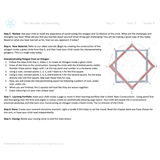- Unit Studies
- >
- Grade 6
- >
- Grade 6 Unit 3 The Wonder of Geometry
Grade 6 Unit 3 The Wonder of Geometry
A balanced artistic and mathematical experience unfolds as your child awakens to the beauty and wonder of the next steps in geometry. This unit includes an introduction to the compass - the wonderful tool that allows for precision in geometry. It is recommended that you and your child complete the Grade 5 Wonder of Freehand Geometry unit before diving into this unit.
This purchase includes one digital month-long curriculum unit with 15 days of lesson plans and 5 days of flexible projects. This unit will inspire you with 55 pages of beautiful images, clear instructions and video tutorials for each of the 25 geometric constructions.
And that's not all. You will also gain access to our members-only area, which includes supporting documents, videos, resources, and a community.
The Wonder of Geometry
Curriculum Areas/Learning Standards
Concept: Properties of objects and shapes can be described, measured, and compared using volume, area, perimeter, and angle.
Connection: Your child will work with these concepts in their Grade 6 math workbook. They will learn how to copy and construct angles and shapes using a compass.
Language Arts
Concept: Questioning what we hear, read, and view contributes to our ability to be educated and engaged citizens.
Connection: Have a regular morning conversation with your child, checking in about information on current events they have heard from friends, newspapers, or television. Find out their opinion on it and support healthy questioning.
Social Studies
Concept: Media sources can both positively and negatively affect our understanding of important events and issues.
Connection: As you connect with your child on days 1-5 regarding current events that they are learning about from various media sources, it is important that they come to understand that we must consider the source of the news and whether there is a bias and what it might be.
Science
Concept: Multicellular organisms rely on internal systems to survive, reproduce, and interact with their environment.
Connection: Have your child investigate what our body systems need for survival. Perhaps this can be connected to the current events they are hearing about and questioning. Demonstrate a sustained curiosity about a scientific topic or problem of personal interest. Conduct a scientific inquiry. The following is a breakdown of the steps in a scientific inquiry. Your child will be guided through these steps from days 6-15.
Curriculum Overview
The constructions are an exercise in self-discipline and focus. The decoration of the form is an opportunity to express creative personality. Encourage your child to have fun and take the time to bring the beauty of the form into its fullest potential. Doing an online search of Waldorf Grade 6 Geometry can be an inspiration for your child.









